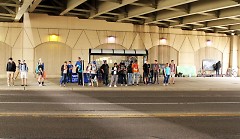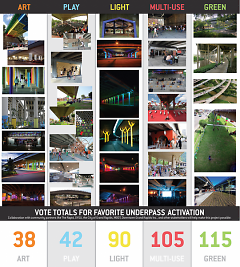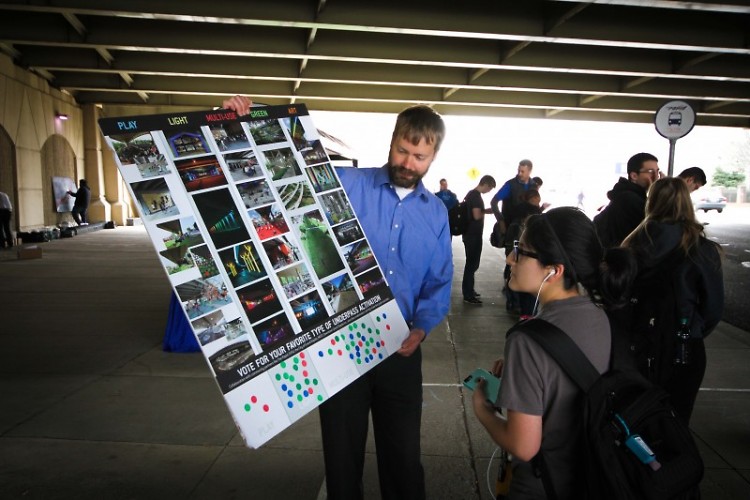
Route 50 riders waiting for the bus. /The Rapid

Laker Line underpass activation voting results. /The Laker Line Study
This dispatch was added by one of our Nonprofit Neighbors. It does not represent the editorial voice of The Rapidian or Community Media Center.

Kevin Wisselink, Senior Planner at The Rapid gathers input from bus rider. /The Rapid

Route 50 riders waiting for the bus. /The Rapid

Laker Line underpass activation voting results. /The Laker Line Study
On April 20, 2016, at the Fulton Street bus stop under US-131, Route 50 bus riders were met with art, hammocks, chalk designs, food trucks and most importantly, an opportunity to provide input for the future design of the Laker Line.
The Laker Line pop-up transit plaza and underpass activation demonstration included tactical and quick-build projects to illustrate, for one day, the potential enhancements that could be realized through collaborative city building. Project partners included The Rapid, City of Grand Rapids, Grand Valley State University, Downtown Grand Rapids, Inc. and the Michigan Department of Transportation.
“This one-day project – the first of its kind in Grand Rapids – provided a unique opportunity for these entities to take small risks and be nimble advocates in the name of transparent and inclusive public input and involvement,” said Lynée Wells, principal and urban planner at Williams & Works, who is leading the project team’s public involvement lead.
Underpasses like the one at Fulton and Mt. Vernon, while integral to traversing a city, are mostly forgotten. This is why the Laker Line project team sought to transform US-131 as a canvas. Many cities throughout the world have underpasses, featuring decorative lighting, colorful paint and play equipment. In fact, one community in Oregon built an entire skate park underneath the bridge structures.
For those of you unfamiliar with Grand Rapids public transportation happenings, The Rapid and Grand Valley State University (GVSU) have been studying Route 50, the Campus Connector between Grand Rapids and Grand Valley State University Allendale Campus since 2013. Ridership has increased dramatically (an average of 13,000 riders daily) over the past few years, which has highlighted a need for improvement to better meet the demand. The 2014 Laker Line Feasibility Study found that bus rapid transit (BRT)--yes, like the Silver Line--would be the best solution for Route 50.
Earlier this year the Federal Transit Administration recommended that the Laker Line be added into the 2017 federal budget. The budget required for the new bus line totals $71 million. However, the federal and state government is footing the bill after research dating back to 2013 has shown just how useful this change will be. Currently, the Laker Line BRT is slated to open in 2018.
The 13-mile BRT line will operate similar to light rail, but for a fraction of the cost. Laker Line stations will feature real-time arrival information, level boarding, emergency phones, security cameras and lighting ticket vending machines. Vehicles will be articulated with room for 90 passengers at a time, as well as being equipped with Wi-Fi and traffic signal priority.
As part of the Laker Line BRT design phase, to test the viability of station placement under US-131 at Fulton Street, the one-day pop-up project provided riders and, perhaps most importantly, the Laker Line project design team, a unique opportunity to experience the underpass and gain insight into current conditions by observing users, documenting the user experience, and gathering input about potential future investments in transportation infrastructure and placemaking.
The pop-up demonstration included the following:
1. Public Art: Creating small-scale mobile murals where five local muralists shared their artistic vision for beautifying the walls of the underpass.
2. Vibrancy: Activating the space with games, including large-scale Jenga, Connect Four, corn hole and dice.
3. Refreshments: RIX STIX Pronto Pup and Patty Matters food trucks served riders during the lunch hours. Both food trucks ran out of food after serving more than 400 people.
4. Seating: Moveable chairs and tables provided a respite; and were frequently rearranged to take advantage of sunlight.
5. Relaxation: Hammocks were strung from the adjacent billboard support structure to provide a place to relax and enjoy a peaceful moment.
6. Pedestrian safety: A Temporary mid-block crossing and pedestrian island were installed using cones, tape, chalk spray and plants to provide a protected street crossing at Fulton near the Eberhard Center.
7. Lighting: Existing white LED lights were covered with colored acetate to soften the brightness and provide visual interest.
8. Feedback and Input: Participants were asked to prioritize future underpass activation concepts including: play, greening, art, use and lighting. Additionally, a five-question survey asked participants about existing and future pedestrian safety enhancements.
“The results from the public were not surprising. For underpass activation, the most favored concept was greening and play. Riders are looking for something other than the current concrete hardscape under US-131. The challenge will be the lack of light which is needed to grow live plant materials. The design team is exploring creative options to green the space given the environmental constraints,” said Wells.
In terms of pedestrian safety, an overwhelming 83 percent majority of survey respondents (283 out of 342) felt safer using the mid-block crossing. Additionally, survey respondents were most concerned with distracted drivers (66 percent), and 73 percent of respondents felt that there are not enough crosswalks or signage to help make the space safer for pedestrians. Finally, the Laker Line design team realized the environmental constraints of an underpass, including the wind tunnel effect, much lower temperatures, droning road noise and even how birds (and what they leave behind) can contribute to unwelcoming conditions.
The Rapid, along with the Laker Line Study team and project partners, are looking forward to solving these design challenges, and finding creative solutions to turn this forgotten space into an appreciated and desired place.
Learn more about the Laker Line by visiting lakerline.org.
The Rapidian, a program of the 501(c)3 nonprofit Community Media Center, relies on the community’s support to help cover the cost of training reporters and publishing content.
We need your help.
If each of our readers and content creators who values this community platform help support its creation and maintenance, The Rapidian can continue to educate and facilitate a conversation around issues for years to come.
Please support The Rapidian and make a contribution today.